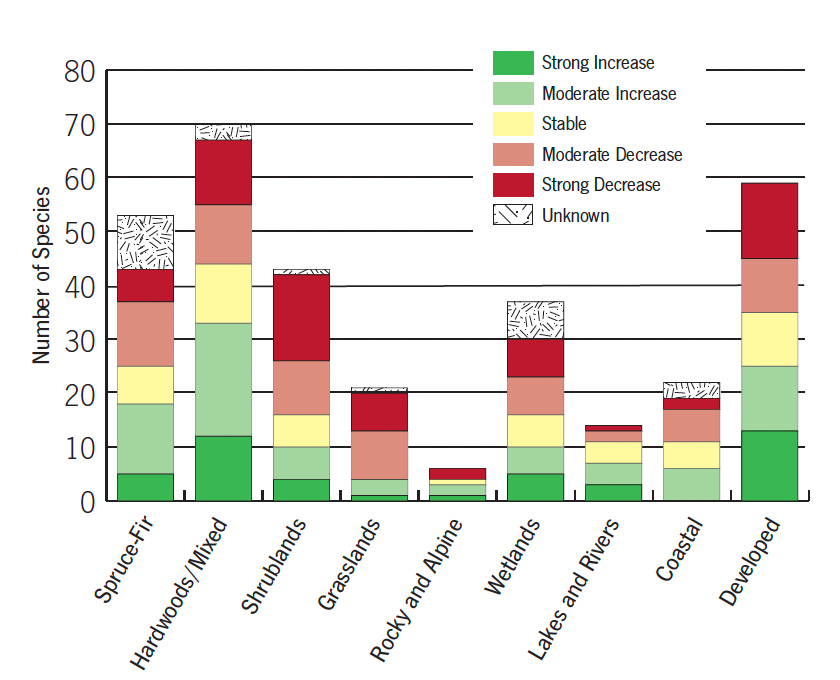Many threats faced by birds are tied to the habitats where they breed, ranging from direct loss to management techniques to invasive species. To better understand the factors influencing populations, all species were assigned to the nine habitat categories below. For each habitat there is a description of its characteristics, population trends among species that breed in the habitat, habitat threats, conservation actions, and data needs. Only breeding species are considered in this section, and a given species may occur in more than one habitat (for example, Purple Finch is in the spruce-fir forest group and also the hardwood-mixed forest). Habitat is important during the non-breeding season as well, and the same breeding season threats are often likely to apply during migration and winter. Non-breeding species were not included in the habitat analyses which follow, but their habitat is listed in the Resources tables. Habitats were based on those used in the New Hampshire Wildlife Action Plan (WAP), prepared by the NH Fish and Game Department in collaboration with conservation partners.

Trend information is presented in two ways in the breeding habitat summaries. For most habitats there is a donut chart, but only showing the trends for species that breed in that habitat. The number of species included in each donut chart is indicated inside the chart. In addition to the donut charts, there are often graphs showing population trends for representative species over the last 50 years. Unless otherwise stated, these graphs are based on Breeding Bird Survey (BBS) data for New Hampshire, and the lines represent an index of abundance over time. For a list of the State’s breeding and regular non-breeding species, plus their habitat associations, see the table in the Resources.

The numbers of increasing/stable and decreasing breeding species are roughly the same when all species are grouped together (above). This is not necessarily the case when species are grouped into habitats. For example, nearly all species dependent on shrubland and grassland habitats have declined. As New Hampshire’s land use has shifted away from rural agricultural, the associated field and farmland habitats are disappearing. Today, these formerly common habitats often occur only when landowners manage their land specifically for wildlife dependent on early successional habitats. In contrast, birds in most other habitats are either doing well (e.g., lakes and rivers, hardwood/mixed forest) or more equally divided between increasing and decreasing species. In spruce-fir forests and wetlands, there are still significant numbers of species with unknown trends, marking these habitats as priorities for future work. Note also that while the prognosis for a habitat as a whole may be reassuring, there may still be species in serious trouble, or threats that pose a significant risk into the future. More detail on such issues is presented in the habitat and threat narratives that follow.
Contact Headquarters

National Wildlife Federation Affiliate
Website By CleverLight
Information for the species profiles on this website was compiled from a combination of the sources listed below.
The Birds of New Hampshire. By Allan R. Keith and Robert B. Fox. 2013. Memoirs of the Nuttall Ornithological club No. 19.
Atlas of the Breeding Birds of New Hampshire. Carol R. Foss, ed. 1994. Arcadia Publishing Company and Audubon Society of New Hampshire
Birds of the World. Various authors and dates. Cornell Laboratory of Ornithology.
Data from the Breeding Bird Survey
Data from the Christmas Bird Count